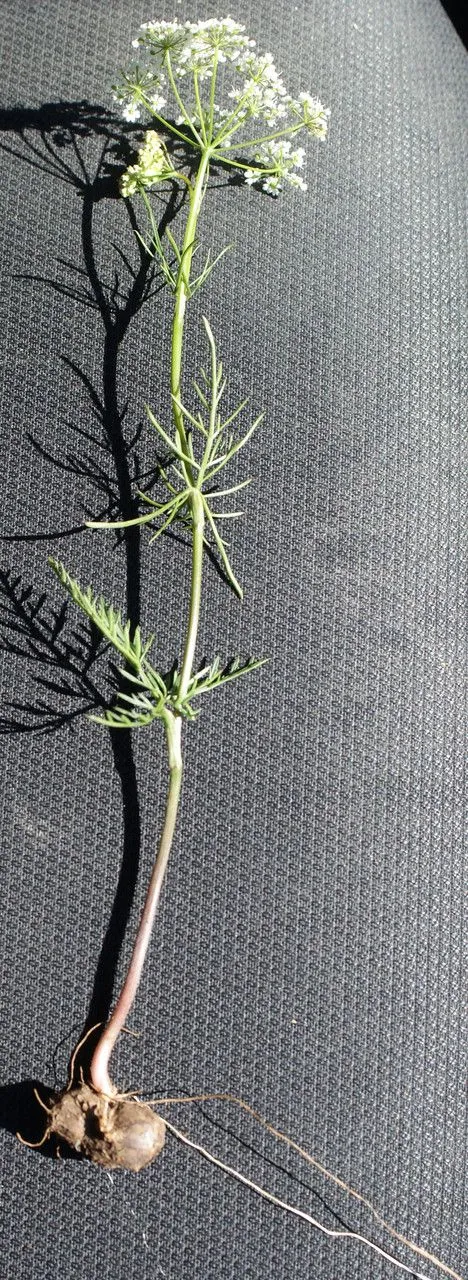
Author: Loret (Gouan)
Bibliography: Fl. Montpellier ed. 2, 214. 1892
Year: 1886
Status: accepted
Rank: species
Genus: Conopodium
Vegetable: True
Observations: W. Europe to Italy
Pignut (Conopodium majus) is a herbaceous perennial plant belonging to the Apiaceae family. This plant is notable for its thin, wiry stems and delicate, feathery foliage, characteristic of many members of the carrot family. The leaves are finely divided and spread out from a single central stalk, giving the plant an elegant and slightly airy appearance.
Pignut thrives in various habitats across Western Europe, from woodlands and hedgerows to grasslands and meadows, extending its range down to Italy. It generally prefers well-drained soils and can often be found in areas with dappled sunlight, growing alongside other native flora. The plant is especially renowned for its small, often inconspicuous white flowers that cluster in umbels, which typically bloom from late spring to early summer.
The underground part of the Pignut is perhaps its most intriguing feature—a small, edible tuber that has a nutty flavor and can be consumed raw or cooked. Traditionally, these tubers were foraged and eaten by local communities, giving rise to the common name “Pignut.” This aspect of the plant has long been appreciated for its culinary uses in the regions it is found.
Conopodium majus was documented in botanical literature as early as the second edition of the “Flore de Montpellier” in 1892, with a thorough description provided by the author Loret, often cited in conjunction with the botanist Gouan. Their observations detailed the plant’s physical characteristics and geographical distribution, contributing significantly to our understanding of this species.
In summary, the Pignut is an important and fascinating component of the Western European flora. Its aesthetic appeal, edible tuber, and historical documentation make it a plant of both ecological and cultural significance.
Deu: französische erd kastanie, französische erdkastanie
Swe: glesstånds, parkstånds, stenkorsört, vårkorsört, nötkörvel, jordnöt
Nor: grisnesvineblom, kolasvineblom, vårsvineblom, jordnødd, knylkörvel
Fin: jokivillakko, kevätvillakko
Dan: park-brandbæger, pilebladet brandbæger, svinenød, vår-brandbæger
Fra: conopode dénudé, grand conopode, génote, janotte
Nld: franse aardkastanje
Eng: pignut, earthnut
Cym: bwyd y moch, bywi, bywien, clor, cnau y moch, cnau’r ddaear, cneuen ddaear, cneuen y ddaear, cneuen y ddaear gyffredin, cylor, daear gnau
En: Pignut, Earthnut, Pig-nut
Ca: Anyol ver
Da: Svinenød, Park-Brandbæger, Pilebladet Brandbæger, Vår-Brandbæger
Nl: Franse aardkastanje
Fi: Jokivillakko, Kevätvillakko
Fr: Conopode dénudé, Grand conopode, Génote, Janotte, Muguette, Noix-de-terre
De: Französische Erd Kastanie, Französische Erdkastanie, Französischer Knollenkümmel
Ga: Cúlarán
It: Bulbocastano piriforme
No: Jordnøtt, Grisnesvineblom, Kolasvineblom, Vårsvineblom, Jordnødd, Knylkörvel
Es: Castañuela
Sv: Nötkörvel, Glesstånds, Parkstånds, Stenkorsört, Vårkorsört, Jordnöt
Cy: Cneuen y ddaear, Bwyd y Moch, Bywi, Bywien, Clor, Cnau y Moch, Cnau’r Ddaear, Cneuen Ddaear, Cneuen y Ddaear Gyffredin, Cylor, Daear Gnau
Taken May 16, 2016 by Tela Botanica − Liliane ROUBAUDI (cc-by-sa)
Taken May 15, 2022 by jm babapc (cc-by-sa)
Taken Jun 10, 2020 by Alain Bigou (cc-by-sa)
Taken Jun 10, 2020 by Alain Bigou (cc-by-sa)
Taken May 3, 2021 by Alain Bigou (cc-by-sa)
Taken May 3, 2021 by Alain Bigou (cc-by-sa)
Taken Jul 20, 2021 by Jan Löser (cc-by-sa)
Taken May 9, 2022 by mulders ilias (cc-by-sa)
Taken Apr 23, 2021 by pauline bouyer (cc-by-sa)
Taken Jul 15, 2019 by Joy Joy Joestar (cc-by-sa)
Taken Jun 4, 2022 by Darren Giddins (cc-by-sa)
Taken Sep 5, 2021 by David Hocken (cc-by-sa)
Taken May 16, 2016 by Tela Botanica − Liliane ROUBAUDI (cc-by-sa)
Taken May 16, 2016 by Tela Botanica − Liliane ROUBAUDI (cc-by-sa)
Taken May 3, 2021 by Alain Bigou (cc-by-sa)
Taken May 5, 2019 by Chris Georges (cc-by-sa)
Taken May 29, 2019 by Andrew Watts (cc-by-sa)
Taken Apr 24, 2022 by Alizée Jung (cc-by-sa)
Taken Nov 25, 2022 by Kilhiann Bagur (cc-by-sa)
Taken Jul 20, 2021 by Jan Löser (cc-by-sa)
Taken Aug 15, 2004 by Photoflora – Jean-Luc TASSET (©)
Taken Aug 15, 2019 by Photoflora – Jean-Luc TASSET (©)
Taken Jun 4, 2017 by Tela Botanica − Henri SCORDIA (cc-by-sa)
Taken Apr 6, 2021 by Ce Ki (cc-by-sa)
Taken May 24, 2020 by Hélène (cc-by-sa)
Taken Jun 15, 2010 by Tela Botanica − Laurent PETIT (cc-by-sa)
Taken May 25, 2013 by Tela Botanica − Alexandre Maccaud (cc-by-sa)
Taken May 8, 2020 by Cam Lpt (cc-by-sa)
Taken Apr 29, 2014 by Tela Botanica − Jean-Claude ECHARDOUR (cc-by-sa)
Taken Apr 25, 2014 by Tela Botanica − Dominique REMAUD (cc-by-sa)
© copyright of the Board of Trustees of the Royal Botanic Gardens, Kew.
© copyright of the Board of Trustees of the Royal Botanic Gardens, Kew.
Ph maximum: 5.5
Ph minimum: 5.0
Light: 6
Atmospheric humidity: 7
Bloom months: [‘jun’, ‘jul’]
Soil nutriments: 5
Family: Myrtaceae Author: (F.Muell.) K.D.Hill & L.A.S.Johnson Bibliography: Telopea 6: 402 (1995) Year: 1995 Status:…
Family: Rubiaceae Author: Pierre ex A.Froehner Bibliography: Notizbl. Bot. Gart. Berlin-Dahlem 1: 237 (1897) Year:…
Family: Sapindaceae Author: Koidz. Bibliography: J. Coll. Sci. Imp. Univ. Tokyo 32(1): 38 (1911) Year:…
Family: Asteraceae Author: A.Gray Bibliography: Pacif. Railr. Rep.: 107 (1857) Year: 1857 Status: accepted Rank:…
Family: Fabaceae Author: Medik. Bibliography: Vorles. Churpfälz. Phys.-Ökon. Ges. 2: 398 (1787) Year: 1787 Status:…
Family: Aspleniaceae Author: (Cav.) Alston Bibliography: Bull. Misc. Inform. Kew 1932: 309 (1932) Year: 1932…